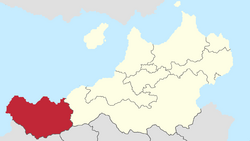Ruttland
Free State of Ruttland
| |
|---|---|
| Anthem: O, brangioji giraitės medis Oh dear rowan tree | |
 | |
| Country | Werania |
| Status | Free state within a federal monarchy |
| Annexation into Werania | 1850 |
| Devolution | 1986 |
| Capital | Šilokrautė |
| Government | |
| • Type | Devolved parliamentary republic in a federal monarchy |
| • Body | Seimas |
| • Minister-Chairman | Raimundas Monkevičius |
| Population (2018) | |
| • Total | 10,792,847 |
| Demonym | Ruttish |
| GDP | |
| • Total | $399,140 million |
| • Per capita | $36,981 |
| Area code | +893 |
| Official languages | Ruttish Weranic |
The Free State of Ruttland (Ruttish: Nemokama Ruttųijos Valstybė) is a constituent state within the Lands of the Weranic Crown. It borders Cislania to the east and has an international border with Vredlandia to the west. It has a population of 10,792,847 and its capital is Šilokrautė whilst its largest city is Lipliškės.
The presence of Ruttish people in the area dates back to the 3rd millennium BC. Under the Solarians Ruttish tribes were never conquored rather existing as tribal, pagan societies that were not united under any single authority. Under the Ahnemunde Confederation in the 950's under Emperor Ludwig II Ruttland was invaded by the confederation with the intention to convert it to Sotirianty. Around the Around the 1st century AD the region was conquered again by the Algirdas dynasty who created the Archduchy of Ruttland, an absolute monarchy within the Ahnemunde Confederation. The Algirdas were able to seize power in the confederation in 1254 under Vilimas I. The Archduchy entered a personal union with the Duchy of Wittislich in 1302 but lost imperial power in 1482 to the Schwarzollen dynasty.
Ruttland continued to exist within the confederation as its most important non-Weranic member, even maintaining a small colonial empire, Vilcasuamanas. Fiscal mismanagement, governmental instability and Ruttland's participation in the Pereramonic Wars meant that Ruttland was significantly weakened. The 1752 the Weranic Revolution led to much of the ruling class to flee to Asteria and in 1760 Ruttland to be annexed into Vredlandia. Following Vredlandia's shift to the Reform Church Ruttland became a centre of nationalist agitation in Vredlandia.
The Vredlandian-Weranian War saw the province of Ruttland ceded to Werania where it became the Kingdom of Ruttland which was in personal union with the Kingdom of Cislania-Brücken, the main component of the Weranic state. A program of Weranicisation was carried out by state authorities leading to frequent nationalist discontent within Ruttland, primarily by the Young Ruttish Party. An unrepresentative voting system that benefited ethnic Weranics compounded this sentiment, making the "Ruttish question" one of the defining political issues of the 1800's and early 1900's in Werania. Following the Great War Ruttland's Weranic dominated landtag was dissolved being replaced with the seimas which subsequently implemented policies reversing Weranicisation. The province would continue to agitate for a strong regional identity leading to in 1986 a successful push by the central government to devolve more power to the region and formally end the monarchy in Ruttland, with the province becoming a free state.
Famed historically for its large steel industry, since deindustrilisation Ruttland has suffered from higher unemployment and lower living standards than the rest of Werania. Ruttland has however undergone a cultural revival in recent years with its capital Šilokrautė being considered one of the most vibrant cities in the country.
History
Prehistory
Early history
Middle Ages
Union with Vredlandia
Imperial era
Post-war history
Government and Politics



